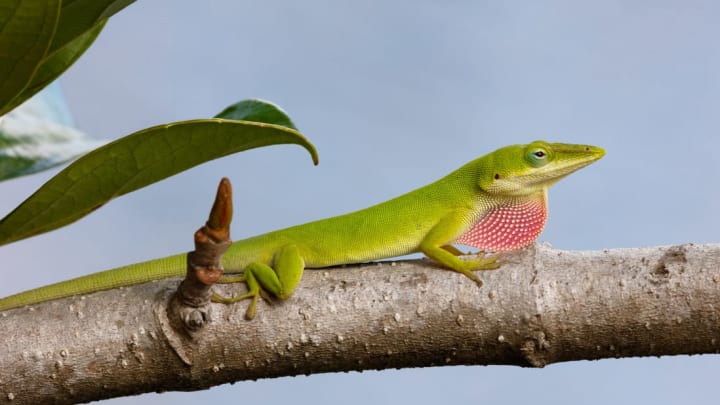We sometimes think of evolution as a thing of the past, but it continues today, especially as environmental pressures force humans and animals to adapt to survive. Here are a few examples of animals evolving in real-time.
1. The lizard with extra sticky feet
The native green lizards—known as Carolina anoles or green anoles—that occupy the lower branches and trunks of Florida’s trees got a rude awakening when their invasive cousins, the brown lizards, moved in. Faced with limited resources and double the competition, the green lizards made a move: they abandoned the lower branches for the treetops. Up there, the limbs are thinner and smoother, so the green lizards’ bodies had to adapt to the environmental shift. To better cling to the smooth branches, their toepads grew bigger and their scales got stickier—in just 15 years and about 20 generations. “The degree and quickness with which they evolved was surprising," Yoel Stuart, a postdoctoral researcher in the College of Natural Sciences at The University of Texas at Austin and lead author of the study, said. "If human height were evolving as fast as these lizards' toes, the height of an average American man would increase from about 5 foot 9 inches today to about 6 foot 4 inches within 20 generations."
2. The shrimp that lost its eyes
In the process of evolutionary change, you either use it or you lose it—and this is certainly true for a group of cave-dwelling crustaceans. These crabs and shrimp live underground where there is no light, and the sense of sight doesn’t do much good. As a result, they’ve gone blind, relying on smell and touch to navigate the cavernous depths. When researchers compared the brains of these spelunkers to their land-dwelling relatives, they found that not only are these creatures sightless, they’re actually losing the parts of their brains associated with vision. Meanwhile, the areas that control touch and smell are getting bigger. "It's a nice example of life conditions changing the neuroanatomy," the study’s lead author, Dr. Martin Stegner, told the BBC. It’s taken about 200 million years for the brain changes to occur, which may not seem “rapid,” but as the Washington Post’s Rachel Feltman wrote, it’s “a relatively short time, in the evolutionary scheme of things.”
3. The owls that are changing color

Climate change is forcing many animals to adapt to survive. The tawny owl in Finland is a good example. These creatures come in two colors, brown or pale gray. The cold white winters have traditionally favored the gray owls, which can hide from predators by blending into a snowy color scheme. But as the winters have become milder over the last 50 years, researchers noticed a shift: gray owls are on the decline and the brown birds are thriving, better suited to blending into the bare brown branches of the forest. As more brown owls survive, more brown genes get passed down through generations. Until now, researchers said, “an evolutionary response to a quantified selection pressure driven by climate change has not been empirically demonstrated in a wild population.”
4. The fish that’s migrating earlier
Climate change is also the driving force behind a recent behavioral shift in pink salmon. As water temperatures rise, the fish are migrating from the ocean to the river to spawn about two weeks earlier than they did 40 years ago. And this isn’t just a new behavior—it’s actually a change at the genetic level. Between the 1980s and 2011, the number of late-migrating salmon declined by 20 percent, according to Ryan Kovach, a population ecologist at the University of Alaska in Fairbanks. The change happened over just one or two generations, which suggests organisms can adapt to climate change very quickly. “We show that there has been a genetic shift towards earlier migration timing through what appears to be natural selection against the late-migrating individuals in the population,” Kovach said.
5. The bedbugs with super-strength

Unfortunately, our long-running battle with these bed-hopping pests has backfired, producing bedbugs with thicker shells and nerve cells of steel to resist the harsh chemicals we lob at them. In 2011, it was found that bedbugs in New York City were 250 times more resistant to pesticides than the bedbugs in Florida, according to researchers at the University of Massachusetts in Amherst. "Insect resistance is nothing more than sped-up evolution," insect toxicologist John Clark said.
6. The mouse that’s immune to poison
Bad news for anyone with a fear of mice: researchers have discovered a house mouse with an immunity to Warfarin, a type of poison typically deployed to fight infestations. The super mice were discovered in Germany, where the lowly house mouse bred with its poison-resistant distant cousin the Algerian mouse. The result? A hybrid mouse with a very useful genetic mutation that gives it a leg up over its rodent relatives. Usually hybrid animals can’t reproduce, but “sometimes there is the occasional odd hybrid that has just about the right novel combination of genomes from two species that renders them, at least temporarily, superior over the pure species," the study’s lead author, Michael Kohn, wrote. “We’ve caught evolution in the act."
This story originally ran in 2015; it has been updated for 2021.
